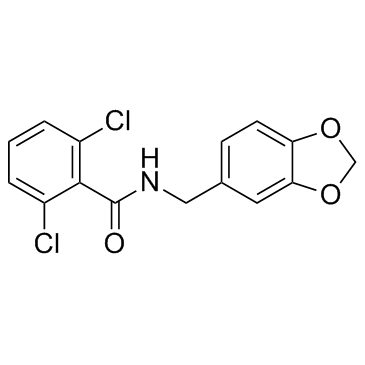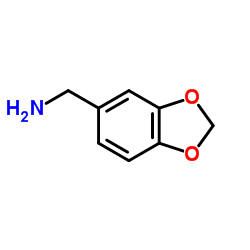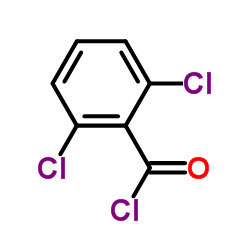Alda 1

Alda 1 structure
|
Common Name | Alda 1 | ||
|---|---|---|---|---|
| CAS Number | 349438-38-6 | Molecular Weight | 324.15900 | |
| Density | N/A | Boiling Point | N/A | |
| Molecular Formula | C15H11Cl2NO3 | Melting Point | N/A | |
| MSDS | Chinese USA | Flash Point | N/A | |
| Symbol |


GHS06, GHS09 |
Signal Word | Danger | |
Use of Alda 1Alda-1 is a potent ALDH2 agonist, which activates wild-type ALDH2 and restores near wild-type activity to ALDH2*2. |
| Name | N-(1,3-Benzodioxol-5-ylmethyl)-2,6-dichlorobenzamide |
|---|---|
| Synonym | More Synonyms |
| Description | Alda-1 is a potent ALDH2 agonist, which activates wild-type ALDH2 and restores near wild-type activity to ALDH2*2. |
|---|---|
| Related Catalog | |
| Target |
ALDH2[1] |
| In Vivo | Alda-1 treatment results in a significant decrease of 4-HNE-protein content in the plasma of apoE−/− mice. Alda-1 administration leads to a slight increase in gene expression related to neurogenesis (Nog), mitochondrial biogenesis (CYTB, ND1), and apoptosis (Bax, Gsk3b) in the Hp of apoE−/− mice. Alda-1 administration leads to 2 and 10 differentially expressed proteins in the FCx and Hp of apoE−/− mice, respectively[1]. Alda-1 (1.5 mg/kg, b.w., i.p.) administration significantly increases the climbing time, tends to reduce the immobility time and increases the swimming time of the prenatally stressed rats in the forced swim test. Moreover, treatment of prenatally stressed rats with Alda-1 significantly increases number of entries into the open arms of the maze and the time spent therein, as assessed by elevated plus-maze test[2]. Alda-1 (8.5 mg/kg, i.p.) with glucose significantly lowers 4-HNE and FJB-positive cells in the cerebral cortex of Alda-1-treated rats than in DMSO-treated rats 24 h after glucose administration[3]. Alda-1 (10 mg/kg per day) treatment prevents aldehydic overload, mitochondrial dysfunction and improves ventricular function in post-MI cardiomyopathy rats[4]. |
| Cell Assay | Spleen cells (4×106 cells/mL) are stimulated by optimal concentrations of concanavalin A (Con A; 2.5 μg/mL and 0.6 μg/mL) and lipopolysaccharide (LPS, 5 μg/mL) and are incubated in 96-well plates at final volume of 0.2 mL for 72 h. Cell proliferation is determined by adding 0.5 μCi of [3H]-thymidine per well at 16 h before the end of the incubation. The cultures are harvested with an automatic cell harvester, and [3H] thymidine incorporation is assessed using a liquid scintillation counter. |
| Animal Admin | After behavioral verification at three months of age, the animals are divided into the following four groups: control, control + Alda-1, prenatally stressed and prenatally stressed + Alda-1 (6 animals per group). Alda-1 injections are given intraperitoneally (i.p.) once daily at a dose of 1.5 mg/kg b.w. (dissolved in 1 mL/kg b.w. DMSO/water 50/50) for 14 days. At the same time, the control and prenatally stressed rats receive 1 mL/kg b.w. DMSO/water 50/50. The injections of Alda-1 and vehicle are given between 10 a.m and 11 a.m. In the last five days of Alda-1 treatment the behavioral parameters in the elevated plus maze test and then in the forced swim test are measured. |
| References |
| Molecular Formula | C15H11Cl2NO3 |
|---|---|
| Molecular Weight | 324.15900 |
| Exact Mass | 323.01200 |
| PSA | 51.05000 |
| LogP | 4.22690 |
| Storage condition | -20℃ |
| Symbol |


GHS06, GHS09 |
|---|---|
| Signal Word | Danger |
| Hazard Statements | H301-H400 |
| Precautionary Statements | P273-P301 + P310 |
| RIDADR | UN 2811 6.1 / PGIII |
|
Aldehyde dedydrogenase-2 plays a beneficial role in ameliorating chronic alcohol-induced hepatic steatosis and inflammation through regulation of autophagy.
J. Hepatol. 62(3) , 647-56, (2015) Mitochondrial aldehyde dehydrogenase (ALDH2) plays a critical role in the detoxification of the ethanol metabolite acetaldehyde. This study was designed to examine the impact of global ALDH2 overexpre... |
|
|
Pharmacological activation of aldehyde dehydrogenase 2 by Alda-1 reverses alcohol-induced hepatic steatosis and cell death in mice.
J. Hepatol. 62 , 1375-81, (2015) Effective therapies for alcoholic liver disease are currently unavailable. The present study tested the efficacy of Alda-1, a specific aldehyde dehydrogenase 2 (ALDH2) activator, in treating alcoholic... |
|
|
Mitochondrial aldehyde dehydrogenase activation by Alda-1 inhibits atherosclerosis and attenuates hepatic steatosis in apolipoprotein E-knockout mice.
J. Am. Heart Assoc. 3(6) , e001329, (2014) Mitochondrial dysfunction has been shown to play an important role in the development of atherosclerosis and nonalcoholic fatty liver disease (NAFLD). Mitochondrial aldehyde dehydrogenase (ALDH2), an ... |
| N-(1,3,5-trimethylcyclohexyl)pyrrolidine |
| Pyrrolidine,1-(1,3,5-trimethylcyclohexyl) |
| Alda-1 |

